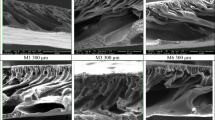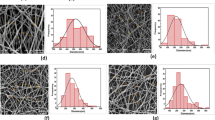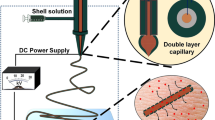Abstract
In this work, microfiber meshes containing embelin, a poorly water-soluble bioactive agent, were prepared by solubilizing embelin in a biodegradable and biocompatible polymer matrix of poly(ɛ-caprolactone) (PCL). Plain or drug-loaded, highly porous, fibrous membranes with a high area-to-volume ratio were obtained by electrospinning. Non-woven microfibrous meshes were formed by uniform bead-free fibers with a mean diameter of 1.2 μm. Non-porous films were obtained by solution casting, and were used for comparison. The drug-loading content of the prepared systems was appropriate for topical applications. The thermal properties revealed that the crystallinity of embelin significantly decreased, the drug having almost completely dissolved in the PCL fibers. The in situ bioavailability of embelin, an antimycotic agent, is an important aspect to consider in topical drug applications. The drug-loaded systems presented different contact areas with the biological environment. When comparing the ability to expose embelin with the biological environment of the prepared systems, drug-loaded fibrous scaffolds showed a higher bioavailability of the bioactive agent because of an increase by 86% in the area-to-volume ratio, providing an effective area per unit mass that was 5.8-fold higher than that of the film. For the meshes, 90% embelin release was observed after 12 h of exposure to phosphate-buffered saline, whereas for the films a comparable level of release occurred only after 72 h.
Similar content being viewed by others
Log in or create a free account to read this content
Gain free access to this article, as well as selected content from this journal and more on nature.com
or
References
Leuner, C. & Dressman, J. Improving drug solubility for oral delivery using solid dispersion. Eur. J. Pharm. Biopharm. 50, 47–60 (2000).
Serajuddin, A. T. Solid dispersion of poorly water-soluble drug: early promises, subsequent problems and recent breakthroughs. J. Pharm. Sci. 88, 1058–1066 (1999).
Brewster, M. E., Verreck, G., Chun, I., Rosenblatt, J., Mensch, J., Van Dijck, A., Noppe, M., Ariën, A., Bruning, M. & Peeters, J. The use of polymer-based electrospun nanofibers containing amorphous drug dispersions for the delivery of poorly water-soluble pharmaceuticals. Pharmazie 59, 387–391 (2004).
Verreck, G., Chun, I., Peeters, J., Rosenblatt, J. & Brewster, M. E. Preparation and characterization of nanofibers containing amorphous drug dispersions generated by electrostatic spinning. Pharm. Res. 20, 810–817 (2003).
Sill, T. J. & Von Recum, H. A. Electrospinning: applications in drug delivery and tissue engineering. Biomaterials 29, 1989–2006 (2008).
Bhardwaj, N. & Kundu, S. C. Electrospinning: a fascinating fiber fabrication technique. Biotech. Adv. 28, 325–347 (2010).
Kenawy, E. R., Abdel-Hay, F. I., El-Newehy, M. H. & Wnek, G. E. Processing of polymer nanofibers through electrospinning as drug delivery systems. Mat. Chem. Phys. 113, 296–302 (2009).
Chakraborty, S., Liao, I.-C., Adler, A. & Leong, K. W. Electrohydrodynamics: a facile technique to fabricate drug delivery systems. Adv. Drug Del. Rev. 61, 1043–1054 (2009).
Greiner, A. & Wendorff, J. H. Electrospinning: a fascinating method for the preparation of ultrathin fibers. Angew. Chem. Int. Ed. 46, 2–36 (2007).
Li, D. & Xia, Y. Electrospinning of nanofibers: reinventing the wheel? Adv. Mater. 16, 1151–1170 (2004).
Albertsson, A. C. & Varma, I. K. Aliphatic polyesters: synthesis, properties and applications. Adv. Polym. Sci. 157, 1–40 (2002).
Haq, K., Ali, M. & Siddiqui, A. W. New compounds from the seeds of Embelia ribes burm. Pharmazie 60, 69–71 (2005).
Raja, S., Unnikrishnan, K. P., Ravindran, P. N. & Balachandran, I. Determination of embelin in Embelia ribes and Embelia tsjeriam-cottam by HPLC. Indian J. Pharm. Sci. 67, 734–736 (2005).
Feresin, G. E., Tapia, A., Sortino, M., Zacchino, S., de Arias, A. R., Inchausti, A., Yaluff, G., Rodriguez, J., Theoduloz, C. & Schmeda-Hirschmann, G. Bioactive alkyl phenols and embelin from Oxalis erythrorhiza. J. Ethnopharmacol. 88, 241–247 (2003).
Sreepriya, M. & Bali, G. Chemopreventive effects of embelin and curcumin against N-nitrosodiethylamine/phenobarbital-induced hepatocarcinogenesis in Wistar rats. Fitoterapia 76, 549–555 (2005).
Wango, E. O. Anti-fertility effects of embelin in female Sprague-Dawley rats may be due to suppression of ovarian function. Acta. Biol. Hung. 56, 1–9 (2005).
Podolak, I., Galanty, A. & Janeczko, Z. Cytotoxic activity of embelin from Lysimachia punctata. Fitoterapia 76, 333–335 (2005).
Mahendran, S., Thippeswamy, B. S. & Veerapur, V. P. Anticonvulsant activity of embelin isolated from Embelia ribes. Phytomedicine 18, 186–188 (2011).
Mahendran, S., Badami, S. & Maithili, V. Evaluation of antidiabetic effect of embelin from Embelia ribes in alloxan induced diabetes in rats. Biomed. Pharmacother. doi:10.1016/j.biopha.2010.08.003.
Patel, R. K., Pundarikakshudu, K., Momin, M. & Patel, M. M. Studies on formulation and in vitro dissolution of embelin tablets. Indian J. Pharm. Sci. 68, 227–230 (2006).
Chitra, M., Sukumar, E., Suja, V. & Devi, C. S. Antitumor, anti-inflammatory and analgesic property of embelin, a plant product. Chemother. 40, 109–113 (1994).
Radhakrishnan, N., Gnanamani, A. & Mandal, A. B. A potential antibacterial agent embelin, a natural benzoquinone extracted from Embelia ribes. Biol. Med. 3, 1–7 (2011).
Van Krevelen, D. W. Properties of Polymers 3rd edn Vol. 121 (Elsevier, Amsterdam, 1990).
Renecker, D. H. & Chun, I. Nanometre diameter fibres of polymer, produced by electrospinning. J. Nanotech. 7, 216–223 (1996).
Gonzalez, M. A., Montini Ballarin, F., Brun, M., Abraham, G. A. & Ballarin, V. Morphological quantification of polymer nanofibers in tissue engineering images. L.A.A.R 42, 89–95 (2012).
Siepmann, J. & Siepmann, F. Mathematical modeling of drug delivery. Int. J. Pharmaceut. 364, 328–343 (2008).
Barr-Howell, B. D. & Gordon, E. J. A study of the transport properties of solvent desorption from experimental films using thermogravimetric analysis. Thermochim. Acta. 180, 147–154 (1991).
Douglas, P., Andrews, G., Jones, D. & Walker, G. Analysis of in vitro drug dissolution from PCL melt extrusion. Chem. Eng. J. 164, 359–370 (2010).
Lee, K. H., Kim, H. Y., Khil, M. S., Ra, Y. M. & Lee, D. R. Characterization of nano-structured poly(ɛ-caprolactone) nonwoven mats via electrospinning. Polymer 44, 1287–1294 (2003).
Zong, X., Kim, K., Fang, D., Ran, S., Hsiao, B. S. & Chu, B. Structure and process relationship of electrospun bioabsorbable nanofiber membranes. Polymer 43, 4403–4412 (2002).
Leuner, C. & Dressman, J. Improving drug solubility for oral delivery using solid dispersion. Eur. J. Pharm. Biopharm. 50, 47–60 (2000).
Acknowledgements
We are grateful to CICITCA-UNSJ and Departamento de Electrónica y Automática (FI UNSJ). PRCT thanks the CONICET and ÂMM thanks the National Council for Scientific and Technological Development (CNPq/Brazil) for the fellowships awarded. We thank Dra MA González for her useful suggestions regarding image processing. This work was supported by the Argentinean National Agency of Scientific and Technological Promotion (PICT 448 grant) and the National Research Council (PIP 522 Grant). The RIMADEL network funded by CYTED is also acknowledged.
Author information
Authors and Affiliations
Corresponding author
Ethics declarations
Competing interests
The authors declare no conflict of interest.
Rights and permissions
About this article
Cite this article
Cortez Tornello, P., Feresin, G., Tapia, A. et al. Dispersion and release of embelin from electrospun, biodegradable, polymeric membranes. Polym J 44, 1105–1111 (2012). https://doi.org/10.1038/pj.2012.80
Received:
Revised:
Accepted:
Published:
Issue date:
DOI: https://doi.org/10.1038/pj.2012.80



